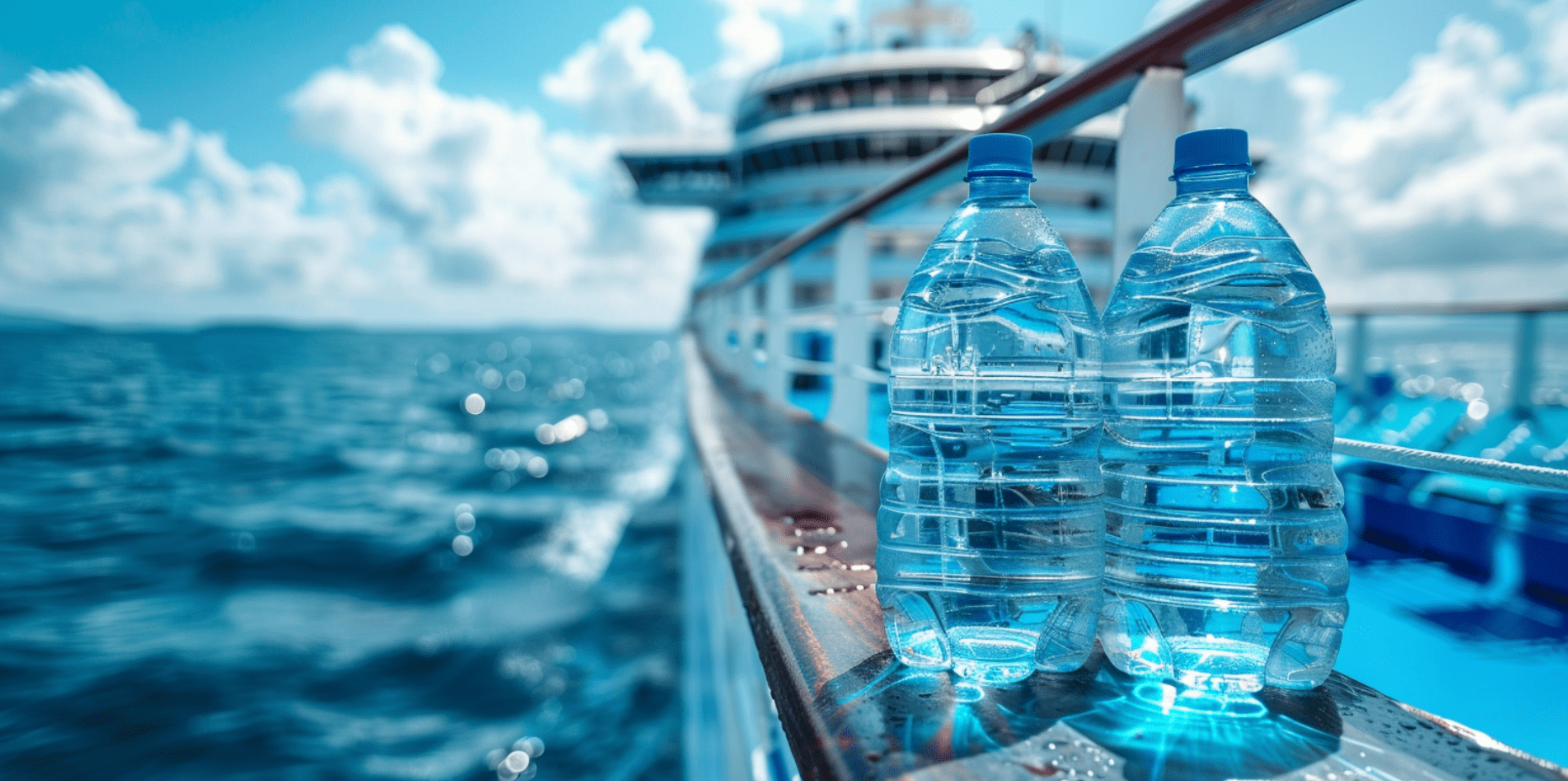When embarking on a luxurious cruise vacation, have you ever wondered how cruise ships ensure a continuous supply of fresh water for their passengers and crew? You might be surprised to learn about the intricate systems and processes of providing clean, safe, and drinkable water onboard these floating cities. This article will explore the fascinating world of cruise ship water management and shed light on the sources of fresh water, the process of desalination, water storage, and treatment systems, as well as cruise tips for conserving water during your journey.
Where Do Cruise Ships Get Their Water: Sources of Fresh Water
Cruise ships rely on various sources to obtain fresh water for drinking and other onboard needs. These sources ensure that passengers and crew can access clean and safe drinking water on cruise ships throughout their journey.
Desalination
Desalination is one of the primary methods cruise ships employ to obtain fresh water. Desalination is the process of removing salt and other impurities from seawater, making it safe for consumption. Cruise ships use advanced desalination technologies such as reverse osmosis, where seawater is forced through a semipermeable membrane to separate salt and other contaminants.
Water Storage and Treatment Systems
Cruise ships are equipped with sophisticated water storage and treatment systems to ensure a continuous fresh water supply. These systems involve storing treated water in onboard tanks and reservoirs. The water goes through rigorous filtration and disinfection processes, including the use of ultraviolet (UV) light or chlorine, to eliminate any remaining impurities and bacteria.
Shore Connections
While at port, cruise ships can connect to the local water supply through shore connections. This allows them to replenish their water reserves without relying solely on onboard production. Port authorities ensure that the water provided to cruise ships meets the necessary quality and safety standards.
In summary, cruise ships obtain fresh water through a combination of desalination, onboard water storage and treatment systems, and shore connections. These processes guarantee a continuous supply of drinking water on board, ensuring the comfort and well-being of passengers and crew throughout their voyage.
Desalination: Turning Saltwater into Fresh Water
Desalination is a crucial process that cruise ships undertake to transform saltwater into fresh water. This ensures a sustainable and continuous drinking water supply for the onboard passengers and crew. Several methods are employed to remove the salt and impurities from seawater, making it safe and suitable for consumption.
Reverse Osmosis
One of the most common methods utilized in cruise ship desalination is reverse osmosis. This process involves passing seawater through a series of semi-permeable membranes, which effectively filter out the salts and contaminants. The purified water that emerges from this process is then stored and distributed throughout the ship.
Thermal Distillation
Thermal distillation is another method employed in the desalination process. This method utilizes heat to evaporate the seawater and separate it from the salts and impurities. The resulting vapor is then condensed and collected as fresh water. The heat required for this process is often generated by waste heat recovery systems on the ship.
Vacuum Freezing
Vacuum freezing is a less common method, but it is still utilized for desalinating water on cruise ships. This process involves freezing the seawater under low pressure and removing the ice crystals. The remaining liquid is then collected and treated to produce fresh water.
These desalination methods play a vital role in ensuring an adequate supply of fresh water on cruise ships, allowing passengers and crew to enjoy their journey without worrying about water shortages. By effectively removing the salt and impurities from seawater, these processes make it possible to meet the high demands for clean water while sailing the open seas.
Water Storage and Treatment Systems
Efficient water storage and treatment systems play a crucial role in providing fresh water on cruise ships. These systems ensure a continuous supply of clean and safe water for the passengers and crew on board. Let’s explore the main aspects of water storage and treatment on cruise ships.
Water Storage:
Cruise ships have dedicated tanks and reservoirs to store fresh water sourced from various locations. These storage systems are often located deep within the vessel to optimize space utilization. The tanks range in size and capacity depending on the ship’s requirements. They are designed to maintain optimum water quality and prevent contamination.
- The storage tanks are made from durable materials like stainless steel to maintain water hygiene and prevent corrosion.
- Regular cleaning and disinfection procedures are carried out to ensure the stored water remains fresh and free from impurities.
Water Treatment:
The stored water undergoes a comprehensive treatment process to meet strict quality standards before being distributed throughout the ship for various purposes, such as drinking, cooking, and hygiene.
- Filtration: The water passes through multiple layers of filters designed to remove sediments, particles, and any visible impurities. Depending on the filtration requirements, these filters can vary from coarse to fine.
- Disinfection: After filtration, the water undergoes a disinfection process to eliminate harmful bacteria, viruses, or other pathogens. This is usually achieved through the use of disinfectant chemicals or ultraviolet (UV) light treatment.
- Monitoring: Regular testing and monitoring are conducted on board the cruise ship to ensure ongoing water quality. This includes checking chlorine levels and pH levels and conducting microbial assessments.
The combination of efficient water storage systems and rigorous water treatment processes guarantees that the water on cruise ships is safe and potable for passengers and crew throughout their voyage.
Managing Water Consumption on Cruise Ships
Efficiently managing water consumption is crucial on cruise ships to ensure a sustainable supply throughout the voyage. By implementing simple tips and strategies, passengers can actively contribute to conserving water resources while enjoying their cruise experience.
- Take shorter showers: Opting for shorter showers reduces water consumption significantly. Remember, every minute counts when conserving water on a cruise.
- Reuse towels: Towels can be reused multiple times before requiring washing. By reusing towels, passengers can help conserve water and energy used in the laundry process.
- Turn off faucets: When brushing teeth or lathering hands, turning off the faucets can save a substantial amount of water. Every drop counts; being mindful of this can make a big difference.
- Report leaks: If passengers notice any leaks or plumbing issues in their stateroom or public areas, they must report them promptly to the ship’s staff. Fixing leaks helps prevent water waste and ensures efficient usage.
- Use the dishwasher: When enjoying meals onboard, using the dishwasher to clean dishes can save water compared to washing by hand. Consolidating dishes and utensils efficiently before running the dishwasher helps maximize water usage.
- Minimize laundry loads: Being mindful of laundry loads and waiting until a full load can help optimize water consumption. If possible, consider re-wearing clothing items that are not visibly soiled to reduce laundry frequency.
By incorporating these simple tips into their daily routine, passengers can actively contribute to water conservation on cruise ships. Conserving water helps protect the environment and ensures a sustainable supply for the present and future generations of cruise-goers.
Shore Connections and Port Water
Shore connections play a vital role in ensuring a continuous supply of fresh water on cruise ships. These connections allow cruise ships to replenish their water supplies while they are docked at ports, reducing the reliance on onboard water production.
Ports provide an essential source of port water for cruise ships. As the ship is docked, it can tap into the port’s water supply through specially designed shore connections. These connections enable fresh water transfer from the port to the ship’s storage tanks, ensuring an ample supply of clean water for various purposes on board.
By utilizing shore connections, cruise ships can efficiently restock their water reserves, especially in areas where access to freshwater sources may be limited. This sustainable approach reduces the need for onboard water production and helps conserve the ship’s energy resources.
The Benefits of Shore Connections for Cruise Ships
- Reliable Water Supply: Shore connections offer a reliable source of fresh water for cruise ships, ensuring an uninterrupted flow of clean water during passengers’ stays on board.
- Reduced Environmental Impact: Cruise ships can minimize their environmental footprint by conserving energy and reducing emissions associated with water production processes by utilizing port water instead of producing water onboard.
- Cost Savings: Shore connections allow cruise ships to save on onboard water production and treatment costs, which can contribute to the cruise industry’s overall sustainability.
- Flexibility: Ports are equipped with the necessary infrastructure to accommodate shore connections, making it convenient for cruise ships to replenish their water supplies in various locations worldwide.
Shore connections provide a practical and sustainable solution for cruise ships to obtain fresh water while docked at ports. By tapping into the port’s water supply, cruise lines can ensure a continuous and reliable water source, benefiting both the passengers and the environment.
Quality Control and Safety Measures for Cruise Ship Water
Ensuring the quality and safety of the water on cruise ships is of utmost importance for the well-being of passengers and crew. Stringent quality control procedures and comprehensive safety measures are in place to guarantee that the water consumed on board is clean and free from any health risks.
Regular Testing and Monitoring
Quality control starts with regular testing of the water throughout the cruise ship. Water samples are collected from various points, including storage tanks, distribution systems, and passenger areas. These samples undergo rigorous analysis to check for any potential contaminants or bacteria. By conducting frequent and thorough testing, cruise ships can promptly identify and address water quality issues.
Compliance with Regulations
In addition to conducting internal testing, cruise ships must comply with stringent regulations set by health authorities and governing bodies. These regulations outline specific guidelines and standards for water quality, ensuring that cruise ships meet or exceed these requirements. Health and safety inspectors regularly audit and monitor compliance with these regulations.
Onboard Health and Safety Teams
Cruise ships employ dedicated health and safety teams responsible for overseeing water quality control. These professionals are trained to monitor and manage the water supply onboard, ensuring it adheres to the highest safety standards. They work closely with the ship’s management to implement preventive measures, promptly respond to concerns, and enforce strict protocols to maintain water quality.
Through regular testing, compliance with regulations, and the expertise of onboard health and safety teams, cruise ships can maintain the highest quality control and safety standards for their water supply. Passengers can enjoy their cruise knowing their water is thoroughly tested and free from potential health risks.
Final Thoughts
In conclusion, fresh water is a vital resource on cruise ships, and numerous systems and processes are in place to ensure its continuous supply.
We have explored the various fresh water sources on cruise ships, including desalination, shore connections, and storage and treatment systems. These systems work together to provide clean, safe water for drinking, cooking, and other onboard needs.
Managing water consumption is also crucial on cruise ships, with passengers encouraged to adopt water-saving practices. By conserving water through simple actions like shorter showers and reusing towels, travelers can contribute to sustainable water management during their cruise vacations.
Overall, understanding the intricate systems and strict quality control measures involved in providing fresh water on cruise ships allows passengers to appreciate the dedication and effort behind this essential resource. So, next time you embark on a cruise journey, raise a glass of refreshing water and savor the knowledge of the complex web of processes that brought it to your fingertips.


